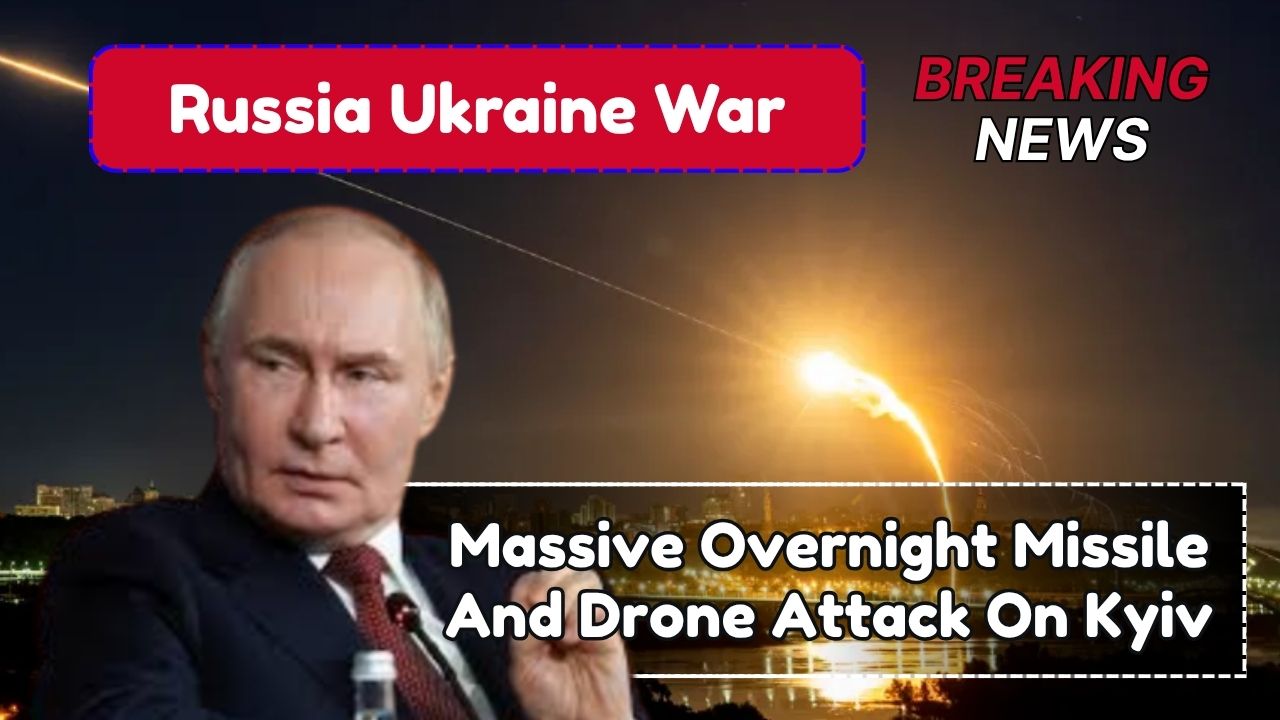Kyiv faced one of its most intense nights of bombardment in recent weeks as Russian missiles and drones targeted the Ukrainian capital in the early hours of Friday. Sirens, explosions and fires were reported across the city as air defence units tried to intercept incoming weapons. Almost every district of Kyiv felt the impact, with damage to residential buildings, heating networks and critical energy facilities.
Local authorities described the assault as a massive enemy attack aimed not only at military or logistical sites but also at the systems that keep the city running. The strikes have once again highlighted how Ukraine’s urban centres and infrastructure remain vulnerable, especially as colder months draw closer and demand for heating increases.
Massive Overnight Attack On Almost Every District

According to Kyiv mayor Vitali Klitschko, almost every district of the city came under attack in the early hours of Friday. Residents were woken by explosions, the sound of air defence systems firing and the distant crackle of secondary blasts as debris fell. Authorities described the assault as one of the most extensive waves directed at the capital in recent months.
Missiles and drones approached from multiple directions, forcing air defence units to spread their resources while trying to protect both the city centre and outlying districts. Mykola Kalashnyk, the head of the Kyiv regional military administration, reported that the main targets included critical infrastructure facilities, suggesting that the strike was designed to disrupt core services rather than only cause short term panic.
Emergency alerts urged residents to stay in shelters until the all clear signal was given. In many districts, people spent hours underground as the attack unfolded in several waves.
Short Summary
Key Point |
Details |
|---|---|
Main Event |
Massive overnight missile and drone attack on Kyiv targeting multiple districts. |
Scale Of Damage |
Residential buildings hit, fires reported, heating and energy networks damaged. |
Casualties |
At least 11 people wounded, five hospitalised, including a pregnant woman and a man in very serious condition. |
Infrastructure |
Energy facilities, rail systems and critical infrastructure struck, raising risk of blackouts. |
International Response |
Canada announced new sanctions, G7 urged an immediate ceasefire and discussed using frozen Russian assets to support Ukraine. |
War Context |
Almost four years into the conflict, both sides are entrenched while Russian forces push in eastern regions. |
Official Site Link |
Official Ukrainian Government: https://www.kmu.gov.ua |
Casualties And Damage To Residential Areas
As the sun rose over Kyiv, the scale of destruction became clearer. At least 11 people were reported injured in the attacks. Five of them required hospitalisation, including a pregnant woman and a man described as being in an extremely serious condition. Earlier reports from separate drone strikes had already mentioned several injuries, showing how frequent and overlapping these assaults have become.
Kyiv officials said that Russians were hitting residential buildings and that damaged high rise blocks could be found throughout the city. In some areas, windows were blown out, balconies ripped open and stairwells filled with dust and smoke. Residents described running through dark corridors, carrying children and elderly relatives to safety while emergency services arrived.
In Solomyansky district, a key transport hub near Kyiv’s international airport, a fire broke out on the roof of a five storey residential building. Firefighters battled the blaze as thick smoke rose above the neighbourhood. Across eight of Kyiv’s ten districts, fires, structural damage or shattered glass were reported, and medical emergency teams were sent to each affected area.
Targeting Energy Infrastructure And Heating Networks
Beyond the visible destruction in homes and streets, the attack also focused heavily on energy and heating infrastructure. Moscow has repeatedly targeted Ukrainian energy facilities and rail systems, seeking to disrupt electricity supply, heating and logistics that support both civilians and the military.
During this latest assault, sections of heating networks were damaged, particularly in the north eastern Desnyansky district. Some buildings were temporarily left without heat, a worrying signal as the temperature drops and winter approaches. Authorities warned that electricity and water supplies could also face disruptions because of damage to substations and pipelines.
Experts have pointed out that repeated strikes on energy infrastructure leave Ukraine at risk of serious heating outages, especially if repair crews cannot restore systems faster than they are being damaged. Each new wave of attacks depletes spare parts, increases maintenance workloads and adds pressure on already stretched utility workers.
War Entering Its Fourth Year With Entrenched Front Lines
The bombardment of Kyiv is part of a wider pattern of strikes across Ukraine as the war approaches its fourth year. Since launching the full scale invasion in 2022, Russia has gradually shifted from short campaigns to a long, grinding conflict in which front lines move slowly and both sides dig in deep.
Russian forces have been pushing across parts of eastern Ukraine, especially in the Donetsk and Lugansk regions. Moscow claims to have captured several more villages along the front line, taking advantage of its larger manpower and equipment reserves. Ukrainian troops are trying to hold defensive positions while also conducting local counterattacks and drone strikes deep behind Russian lines.
Despite the high casualty toll and ongoing destruction, Moscow has rejected calls for a ceasefire. Efforts to revive negotiations or a broader peace deal have stalled, including attempts backed by some international figures and foreign leaders. As a result, residents of cities like Kyiv continue to live under the constant threat of new attacks.
Western Sanctions And Diplomatic Pressure On Russia
The latest attack came as Kyiv’s Western partners moved to tighten sanctions and increase economic pressure on Russia. Canada announced new measures targeting Russian drone production, energy companies and entities involved in cyber infrastructure. These sanctions aim to weaken Moscow’s ability to manufacture weapons, fund the war and launch cyberattacks.
On the same day, foreign ministers from the G7 group of major economies issued a joint call for an immediate ceasefire in Ukraine. They reaffirmed what they described as unwavering support for Ukraine’s territorial integrity and sovereignty. Discussions also took place within the European Commission about using part of the Russian assets frozen after the invasion to provide Ukraine with long term loans for budgetary and military support.
These steps show that the diplomatic and economic pressure on Moscow is still increasing, even though they have not yet produced a breakthrough toward a negotiated settlement.
Humanitarian Concerns And The Road Ahead
For civilians in Kyiv, the latest attack is another reminder that the war remains far from over. Every new barrage brings fresh injuries, psychological trauma and damage to homes that are already scarred from earlier strikes. Volunteers, medical teams and emergency workers continue to respond, but long term recovery will require significant resources.
The main concern in the coming months is the stability of energy supplies. If similar large scale assaults continue, there is a real risk of extended blackouts that would affect heating, water distribution, hospitals and transport. Ukrainian authorities are racing to reinforce key facilities, diversify energy sources and secure additional support from allies.
At the same time, Ukrainians are being urged to remain vigilant, follow air raid instructions and prepare emergency supplies in case of prolonged outages. The resilience of local communities, combined with continued international assistance, will be crucial as the country faces another difficult winter.
Frequently Asked Questions
Q1. What happened during the latest attack on Kyiv?
Russian forces launched a large overnight barrage of missiles and drones against Kyiv. Almost every district was affected, with explosions, fires and significant damage to residential buildings and infrastructure.
Q2. How many people were injured in the strikes on the capital?
Local authorities reported that at least 11 people were injured in this wave of attacks. Five of them were hospitalised, including a pregnant woman and a man described as being in extremely serious condition.
Q3. Why is Russia targeting energy infrastructure in Ukraine?
Russia has repeatedly focused on energy facilities, rail systems and other critical infrastructure to disrupt electricity, heating and transport. This strategy aims to weaken Ukraine’s capacity to support its military and place pressure on civilians, especially during the winter months.
Q4. How did Western countries respond to this escalation?
Canada announced new sanctions against Russian drone and energy production sectors as well as cyber infrastructure. G7 foreign ministers renewed calls for an immediate ceasefire and discussed using frozen Russian assets to provide financial and military support to Ukraine.
Q5. What are the main risks for Kyiv in the coming winter?
The primary concerns are possible heating and power outages caused by repeated strikes on energy networks. If damage accumulates faster than it can be repaired, Kyiv may face serious disruptions to heating, water supply and other essential services during the coldest period of the year.
For More Information Click HERE











